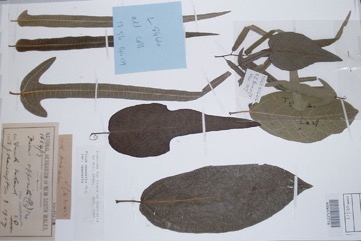Sandpaper fig

It grows in tropical, subtropical and warm temperate locations. It does best in a rich well drained soil. It needs a protected partly shaded position. It is drought and frost tender. It grows from sea level to 750 m above sea level.
Also known as:
Midjinymidjiny, Mindji, Muthi, Muthir', Nyimara, Warrwi
Synonyms
- Ficus aculeata A. Cunn. ex Miq.
- Ficus beckleri Miq.
- Ficus cumingii Miq.
- Ficus fitzalanii Miq.
- Ficus orbicularis A. Cunn. ex Miq.
- Ficus xerophila Domin
- Ficus yarrabensis Domin.
Edible Portion
- Fruit
Where does Sandpaper fig grow?
Found in: Asia, Australia, Indonesia, Pacific, Papua New Guinea, PNG, SE Asia, Torres Strait
Notes: The leaves are used as sandpaper. There are about 800-1000 Ficus species. They are mostly in the tropics. There are 120 Ficus species in tropical America.
Growing Sandpaper fig
Cultivation: Plants are grown from seed. Cuttings and aerial layering could also be tried.
Edible Uses: The ripe fruit are eaten.
Production: In Australia fruit are produced July to February.
Nutrition Info
per 100g edible portion| Edible Part | Energy (kcal) | Protein (g) | Iron (mg) | Vitamin A (ug) | Vitamin c (mg) | Zinc (mg) | % Water |
|---|---|---|---|---|---|---|---|
| Flower | - | 2.7 | - | - | - | - | 66.5 |
| Fruit | 131 | 4 | 0.1 | - | 234 | 0.1 | 72.1 |
Sandpaper fig Photos

References
Anon., 2003, Native Plants for the Fitzroy basin. Society for Growing Australian Plants Inc. (Rockhampton Branch) p 55
Beasley, J., 2011, Plants of Tropical North Queensland - the compact guide. Footloose publications. p 51
Bodkin, F., 1991, Encyclopedia Botanica. Cornstalk publishing, p 473
Brock, J., 1993, Native Plants of Northern Australia, Reed. p 188
Calvert, G., 2010, The Burdekin Delta Tree Guide. Lower Burdekin Landcare Association., Inc., Ayr p 81
Cooper, W. and Cooper, W., 2004, Fruits of the Australian Tropical Rainforest. Nokomis Editions, Victoria, Australia. p 326
Crawford, I. M., 1982, Traditional Aboriginal Plant Resources in the Kalumburu Area: Aspects in Ethno-economics. Records of the Western Australian Museum Supplement No. 15
Elliot, W.R., & Jones, D.L., 1992, Encyclopedia of Australian Plants suitable for cultivation. Vol 4. Lothian. p 288
Fell, D.G. & Stanton, D.J., 2015: The vegetation and flora of Mabuyag, Torres Strait, Queensland. Memoirs of the Queensland Museum – Culture 8(1):1-33. Brisbane. ISSN 1440-4788.
Flora of Australia, Volume 3, Hamamelidales to Casuarinales, Australian Government Publishing Service, Canberra (1989) p 56
Hibbert, M., 2002, The Aussie Plant Finder 2002, Florilegium. p 102
Hiddins, L., 1999, Explore Wild Australia with the Bush Tucker Man. Penguin Books/ABC Books. p 161
Jackes, B.R., 2001, Plants of the Tropics. Rainforest to Heath. An Identification Guide. James Cook University. p 66
Lands, M., 1987, Mayi: Some Bush fruits of Dampierland. Magabala Books, Broome West Australia. p 53
Lazarides, M. & Hince, B., 1993, Handbook of Economic Plants of Australia, CSIRO. p 114
London J. Bot. 7:426. 1848
Low, T., 1991, Wild Food Plants of Australia. Australian Nature FieldGuide, Angus & Robertson. p 147
Melzer, R. & Plumb, J., 2011, Plants of Capricornia. Belgamba, Rockhampton. p 207
Milson. J., 2000, Trees and Shrubs of north-west Queensland. DPI p 172
Mua Bioversity Profile, 2013, Profile for Management of the Habitats and Related Ecological and Cultural Resources of Mua Island. Torres Strait Regional Authority Land & Sea Management Unit. p 142
Paczkowska, G . & Chapman, A.R., 2000, The Western Australian Flora. A Descriptive Calatogue. Western Australian Herbarium. p 331
Petheram, R.J. and Kok, B., 2003, Plants of the Kimberley Region of Western Australia. UWA Press p
Smith, K & I., 1999, Grow your own bushfoods. New Holland. Australia. p 35
Smith, N and Wightman, G.M., 1990, Ethnobotanical Notes from Belyuen Northern Territory Australia. Northern Territory Botanical Bulletin No 10. Parks and Wildlife Commission of the Northern Territory. p 14, 15
Smith, N. M., 1991, Ethnobotanical Field Notes from the Northern Territory, Australia, J. Adelaide Bot. Gard. 14(1): 1-65
Townsend, K., 1994, Across the Top. Gardening with Australian Plants in the tropics. Society for Growing Australian Plants, Townsville Branch Inc. p 213
Townsend, K., 1999, Field Guide to Plants of the Dry Tropics. Society for Growing Australian Plants, Townsville Branch Inc. p 57
Vigilante, T., et al, 2013, Island country: Aboriginal connections, values and knowledge of the Western Kimberley islands in the context of an island biological survey. Records of the Western Australian Museum Supplement 81: 145-182
Wheeler, J.R.(ed.), 1992, Flora of the Kimberley Region. CALM, Western Australian Herbarium, p 80
Wightman, Glenn et al. 1991.Alawa Ethnobotany: Aboriginal Plant Use from Minyerri, Northern Australia. Northern Territory Botanical Bulletin No 11. Parks and Wildlife Commission of the Northern Territory. p 16, 15.
Wightman, Glenn et al. 1992, Mangarrayi Ethnobotany: Aboriginal Plant Use from the Elsey Area Northern Australia. Northern Territory Botanical Bulletin No 15. Parks and Wildlife Commission of the Northern Territory. p 26, 27.
Smith, Nicholas et al. 1993, Ngarinyman Ethnobotany: Aboriginal Plant Use from the Victoria River Area Northern Australia. Northern Territory Botanical Bulletin No 16. Parks and Wildlife Commission of the Northern Territory. p 26, 27.
Wightman, Glenn et al. 1994, Gurindji Ethnobotany: Aboriginal Plant Use from Daguragu Northern Australia. Northern Territory Botanical Bulletin No 18. Parks and Wildlife Commission of the Northern Territory. p 29, 28
Williams, K.A.W., 1999, Native Plants of Queensland Volume 4. Keith A.W. Williams North Ipswich, Australia. p 196
World Checklist of Useful Plant Species 2020. Royal Botanic Gardens, Kew